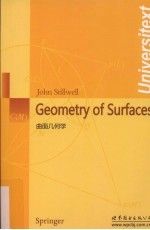

曲面几何学 英文版PDF电子书下载
- 电子书积分:10 积分如何计算积分?
- 作 者:JohnStillwell著
- 出 版 社:世界图书北京出版公司
- 出版年份:2010
- ISBN:9787510005312
- 页数:216 页
Chapter 1.The Euclidean Plane 1
1.1 Approaches to Euclidean Geometry 1
1.2 Isometries 2
1.3 Rotations and Reflections 5
1.4 The Three Reflections Theorem 9
1.5 Orientation-Reversing Isometries 11
1.6 Distinctive Features of Euclidean Geometry 14
1.7 Discussion 18
Chapter 2.Euclidean Surfaces 21
2.1 Euclid on Manifolds 21
2.2 The Cylinder 22
2.3 The Twisted Cylinder 25
2.4 The Torus and the Klein Bottle 26
2.5 Quotient Surfaces 29
2.6 A Nondiscontinuous Group 33
2.7 Euclidean Surfaces 34
2.8 Covering a Surface by the Plane 36
2.9 The Covering Isometry Group 39
2.10 Discussion 41
Chapter 3.The Sphere 45
3.1 The Sphere S2 in R3 45
3.2 Rotations 48
3.3 Stereographic Projection 50
3.4 Inversion and the Complex Coordinate on the Sphere 52
3.5 Reflections and Rotations as Complex Functions 56
3.6 The Antipodal Map and the Elliptic Plane 60
3.7 Remarks on Groups,Spheres and Projective Spaces 63
3.8 The Area of a Triangle 65
3.9 The Regular Polyhedra 67
3.10 Discussion 69
Chapter 4.The Hyperbolic Plane 75
4.1 Negative Curvature and the Half-Plane 75
4.2 The Half-Plane Model and the Conformal Disc Model 80
4.3 The Three Reflections Theorem 85
4.4 Isometries as Complex Functions 88
4.5 Geometric Description of Isometries 92
4.6 Classification of Isometries 96
4.7 The Area of a Triangle 99
4.8 The Projective Disc Model 101
4.9 Hyperbolic Space 105
4.10 Discussion 108
Chapter 5.Hyperbolic Surfaces 111
5.1 Hyperbolic Surfaces and the Killing-Hopf Theorem 111
5.2 The Pseudosphere 112
5.3 The Punctured Sphere 113
5.4 Dense Lines on the Punctured Sphere 118
5.5 General Construction of Hyperbolic Surfaces from Polygons 122
5.6 Geometric Realization of Compact Surfaces 126
5.7 Completeness of Compact Geometric Surfaces 129
5.8 Compact Hyperbolic Surfaces 130
5.9 Discussion 132
Chapter 6.Paths and Geodesics 135
6.1 Topological Classification of Surfaces 135
6.2 Geometric Classification of Surfaces 138
6.3 Paths and Homotopy 140
6.4 Lifting Paths and Lifting Homotopies 143
6.5 The Fundamental Group 145
6.6 Generators and Relations for the Fundamental Group 147
6.7 Fundamental Group and Genus 153
6.8 Closed Geodesic Paths 154
6.9 Classification of Closed Geodesic Paths 156
6.10 Discussion 160
Chapter 7.Planar and Spherical Tessellations 163
7.1 Symmetric Tessellations 163
7.2 Conditions for a Polygon to Be a Fundamental Region 167
7.3 The Triangle Tessellations 172
7.4 Poincaré's Theorem for Compact Polygons 178
7.5 Discussion 182
Chapter 8.Tessellations of Compact Surfaces 185
8.1 Orbifolds and Desingularizations 185
8.2 From Desingularization to Symmetric Tessellation 189
8.3 Desingularizations as(Branched) Coverings 190
8.4 Some Methods of Desingularization 194
8.5 Reduction to a Permutation Problem 196
8.6 Solution of the Permutation Problem 198
8.7 Discussion 201
References 203
Index 207
- 《卓有成效的管理者 中英文双语版》(美)彼得·德鲁克许是祥译;那国毅审校 2019
- 《AutoCAD 2018自学视频教程 标准版 中文版》CAD/CAM/CAE技术联盟 2019
- 《跟孩子一起看图学英文》张紫颖著 2019
- 《AutoCAD机械设计实例精解 2019中文版》北京兆迪科技有限公司编著 2019
- 《复分析 英文版》(中国)李娜,马立新 2019
- 《张世祥小提琴启蒙教程 中英文双语版》张世祥编著 2017
- 《生物化学 本科临床 英文版》张晓伟 2018
- 《理想国 全英文原版》(古希腊)柏拉图著 2017
- 《Dreamweaver CC 2018标准实例教程 中文版》杨雪静,胡仁喜编著 2019
- 《Flash CC动画制作实用教程 中文版》麓山文化 2019
- 《中风偏瘫 脑萎缩 痴呆 最新治疗原则与方法》孙作东著 2004
- 《水面舰艇编队作战运筹分析》谭安胜著 2009
- 《王蒙文集 新版 35 评点《红楼梦》 上》王蒙著 2020
- 《TED说话的力量 世界优秀演讲者的口才秘诀》(坦桑)阿卡什·P.卡里亚著 2019
- 《燕堂夜话》蒋忠和著 2019
- 《经久》静水边著 2019
- 《魔法销售台词》(美)埃尔默·惠勒著 2019
- 《微表情密码》(波)卡西亚·韦佐夫斯基,(波)帕特里克·韦佐夫斯基著 2019
- 《看书琐记与作文秘诀》鲁迅著 2019
- 《酒国》莫言著 2019
- 《TED说话的力量 世界优秀演讲者的口才秘诀》(坦桑)阿卡什·P.卡里亚著 2019
- 《小手画出大世界 恐龙世界》登亚编绘 2008
- 《近代世界史文献丛编 19》王强主编 2017
- 《课堂上听不到的历史传奇 世界政治军事名人 初中版》顾跃忠等编著 2015
- 《指向核心素养 北京十一学校名师教学设计 英语 七年级 上 配人教版》周志英总主编 2019
- 《365奇趣英语乐园 世界民间故事》爱思得图书国际企业 2018
- 《近代世界史文献丛编 36》王强主编 2017
- 《北京生态环境保护》《北京环境保护丛书》编委会编著 2018
- 《近代世界史文献丛编 11》王强主编 2017
- 《近代世界史文献丛编 18》王强主编 2017
